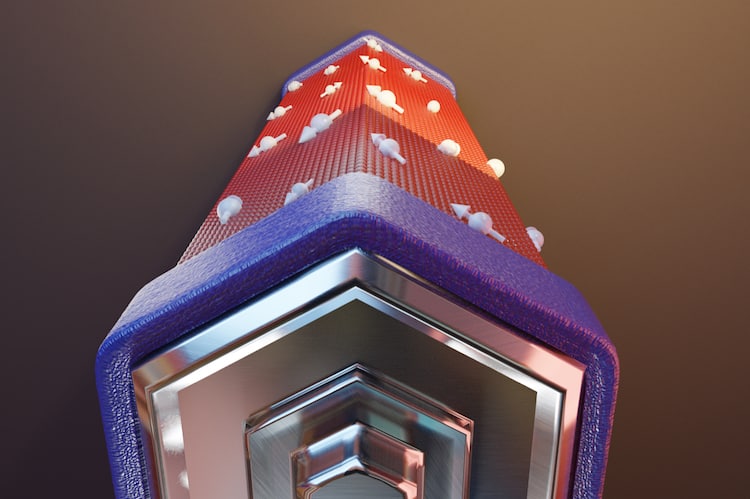Scientists unveil Josephson diode
04 May 2022
An international group of physicists has demonstrated that a very thin layer of quantum-mechanical material sandwiched between two pieces of superconductor can conduct electricity with or without resistance depending on the direction of the voltage applied. The new “Josephson diode” operates in the absence of a magnetic field and could, the team says, lead to a new generation of faster, more energy-efficient electronics.
Conventional diodes are put to a wide range of uses, including the conversion of alternating to direct current, the demodulation of radio signals, and as components inside logic gates. They are usually made from a p–n junction; that is, from pieces of positively and negatively doped silicon joined together. With some of the excess “holes” (regions of positive charge) and electrons combining, the region around the join becomes insulating, like undoped silicon. The result is a device that conducts electricity in only one direction when the negative terminal of a battery is connected to the n-type region, such that electrons are pushed into the p-type region.
The ability to transmit such one-way currents in superconducting circuits could save significant amounts of energy. Superconductors are materials that conduct without resistance when cooled below a certain critical temperature at which it becomes energetically favorable for electrons to form pairs that glide unimpeded through the material’s crystal lattice. They are used, for example, to make bits for quantum computers and in high-strength magnets. Since superconducting switches are particularly speedy, a superconducting diode could also lead to faster devices.
Scientists have already demonstrated how superconducting diodes could be made. In 2020, researchers in Japan observed a superconducting current flowing one way across a thin stack of three different metals. This result came about due to the material’s inherent properties rather than the presence of a junction, but, as with other similar demonstrations, their feat relied on applying a magnetic field across the material.
Field-free flow
In the latest work, Mazhar Ali of the Delft University of Technology in the Netherlands and colleagues in Europe, the US, and China note that such a field is needed to carry out the symmetry breaking essential for uni-directional current flow. The “non-centrosymmetric” conductor used in the 2020 demonstration breaks spatial symmetry, meaning it distinguishes between electrons with positive and negative momentum. In addition, however, the system must also break temporal symmetry – allowing spin-up electrons with positive momentum to behave differently from spin-down electrons with negative momentum.
Group members Heng Wu and Yaojia Wang have now shown how to break both types of symmetry using a novel type of Josephson junction. A regular Josephson junction consists of a very thin insulating (or non-superconducting) layer sandwiched between two superconducting layers. In this structure, pairs of superconducting electrons can tunnel across the gap between them as long as the current remains below a certain limit.
The new device instead comprises a flake of niobium bromide just a few atoms thick placed between layers of a superconducting material, niobium diselenide. The niobium bromide, made by group members at Johns Hopkins University in the US, is a two-dimensional quantum material like graphene, and it has been predicted to contain a net electric dipole – thereby exhibiting the symmetry breaking needed to build a superconducting diode.
By carrying out a series of experiments at temperatures as low as 20 millikelvins, the researchers demonstrated that the device functioned as a superconductor when the current flowed in one direction while exhibiting normal resistive behavior in the other. Notably, they confirmed that no magnetic field was needed to achieve this diode effect – showing that while the effect was present with zero fields it disappears when the junction is exposed to higher fields.
An uncertain mechanism
Ali and colleagues report that they have collected very similar data using materials from different batches analyzed in different labs – giving them confidence that their results were not due to some artifact of the experimental set-up or to user error. However, they are not entirely sure about the physical mechanism behind the effect. They think that polarization within the three-layer device leads to a similar effect as in the p–n junction of a normal diode, but say that further theoretical and experimental work is needed to confirm this idea.
They add that building a practical device will involve replacing niobium diselenide with a more complex superconductor that operates at higher temperatures – preferably above 77 K, at which point they could use relatively cheap liquid-nitrogen cooling. They will also need to scale up production from the handful of devices they made for their laboratory experiments to chips containing millions of Josephson diodes.
Should they succeed, they reckon that their technology could have major commercial applications. Although likely to be too complex for use in domestic computers, they say that their diodes are potentially well-suited to centralized facilities such as server farms or supercomputers. “The existing infrastructure could be adapted without too much cost to work with Josephson diode-based electronics,” says Ali.READ MORE

Toshiya Ideue of the University of Tokyo, Japan regards the latest work as “big progress” in the development of superconducting diodes. He thinks that measuring the response of different combinations of superconducting and non-superconducting quantum materials, with varying relative orientations, could help reveal the physical mechanism involved in the field-free diode effect, which would, in turn, shed light on other exotic properties of such materials. But he cautions that mass-producing devices made from these materials will not be easy. This fabrication challenge, he says, “must be solved for practical use”.
The research is reported in Nature.
Edwin Cartlidge is a science writer based in Rome.
from physicsworld.com 13/5/2022

Δεν υπάρχουν σχόλια:
Δημοσίευση σχολίου